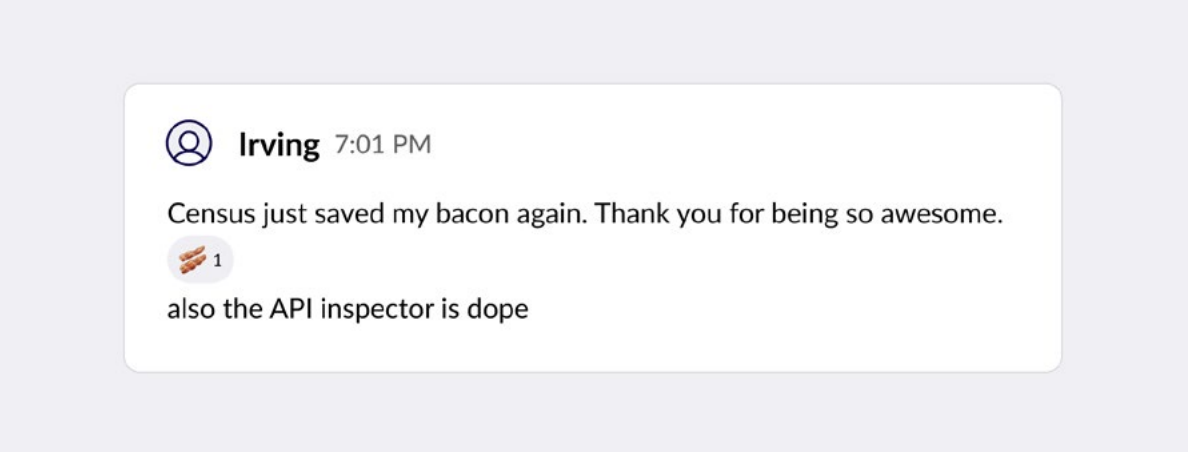This is the final part of our series on evaluating reverse ETL tools. This was updated December 16, 2022 to better capture the current state of reverse ETL tooling. You can read part one here, part two here, and part 3.1 here. We’ve also created a comprehensive resource to help you find the best reverse ETL tool, which you can find here.
In this installment, you’ll learn four (more) key things you should consider as you evaluate reverse ETL solutions, including:
- Ease of use for Data and Ops teams 👐
- Ongoing community & vendor support 🤝
- Transparent and predictable pricing 💰
- Visual segmentation 👀
To wrap things up, we’ll also discuss some next steps for setting yourself up for success with reverse ETL. 🚀
In the final installment of our series on evaluating reverse ETL tools, we’re narrowing in on four more key considerations you should use to grade your options for reverse ETL.
Up to now, we’ve talked about why reverse ETL is such a key part of today’s modern data stack, why you really, really, really don’t want to build reverse ETL tooling yourself, and four other key considerations to measure vendors against.
As we wrap up the series, we hope that you’ve seen the potential of reverse ETL tools to unite your data and business teams to achieve operational analytics (which is a fancy way of saying you can do more with your data in the frontline business tools -- like Salesforce, HubSpot, Marketo, and Braze -- you and your customers rely on).
Without further ado, let’s take a look at the final three key considerations to keep in mind as you choose the best reverse ETL tool for your use case. If you diligently compare each option against these criteria, you’ll end up with a reverse ETL platform that supports your business today, and into the future.
1. Ease of use for Ops and Data teams 👐
If you’re like us, you’re always looking for best-in-class tooling that doesn’t just make your data better but makes your life easier, too. Reverse ETL can do that with an intuitive user interface and SQL fluency to make it accessible to anyone on your team with SQL knowledge. Both of which are a giant step toward self-service and data democratization.
Here’s what we mean by ease of use, as well as some additional usability considerations to keep in mind as you evaluate.
1. Your reverse ETL tool should speak SQL. This means anyone on your team that speaks SQL can create a sync and start activating data in the warehouse with ease. This helps you tap into the talented people within your organization immediately – whether they’re a data analyst, data engineer, data scientist, or ops unicorn in sales, marketing, or finance.
2. Your reverse ETL tool should be easy to use. There shouldn’t be any headaches to figuring out how to create and manage syncs. Your tool should have an intuitive UX that makes it easy to create connections to sources and destinations and easily map the data you need with point-and-click data mapping.
3. Your reverse ETL tool should let you flexibly create SQL models. You should be able to easily create a SQL model to define logic and data structure for your syncs, whether that’s in your warehouse as tables or views, natively in the reverse ETL tool itself, or as a dbt model. This includes:
a. The ability to define SQL models inside the tool.
b. The ability for non-technical users to self-serve data and sync it to their tools.
c. Native dbt and Looker integrations. (Bonus: Your reverse ETL tool should allow you to re-trigger your syncs when your model updates — e.g. when you add a new column to your model)
4. Your business users shouldn’t have to speak SQL. Marketing operations managers shouldn’t be left out of the fun because they don’t have a CS degree. The reverse ETL best practice is to allow data professionals to “bless” and approve models and empower business users to filter these models flexibly as their requirements change.
If your new reverse ETL tool ticks all of the boxes above, you and your team are off to a great start to doing more with your data from day one. After all, the best reverse ETL tool should help elevate the skill sets and insights of every member of your team. Data for one, data for all.

2. Ongoing community & vendor support 🤝
Try as any vendor may, there will be times that troubleshooting is necessary (or just times that you or your team have questions about best practices to become better reverse ETL power users). It’s during these times that ongoing community and vendor support are important.
Vendors and the communities that they maintain should offer support not just for their product, but the most common integrations they work with. After all, unlike ETL tools which sync from business systems into the warehouse as a destination, syncing back into business tools exponentially increases the number of questions, issues, and quirks folks can run into.
Beyond receiving alerts and having great docs to help you solve issues yourself, high-quality support and community help you trust your vendor’s team and learn more in the process. They should make your job easier, faster, and more rewarding. They should have your back and make sure you’ve got the tools and knowledge you need to get your work done.
For instance, at Census, we understand everything about our customers. We have a deep relationship with them and act as their trusted advisors. Because our 25 KPIs are their KPIs, we understand their business just as well as they do to help them build solutions that fit their needs.

To ensure that your future reverse ETL vendor offers the support and reassurance you need to get help when something goes awry and up-level your skills as the industry changes, focus on the following five things when evaluating the company:
1. A demonstrated commitment to keeping SLAs. Downtime SLAs of at least 99.99% show your vendor takes availability seriously and will make all efforts to keep service running for you. This could even include downtime compensation.
2. Top-tier support & in-app support. This basically just means how easy it is to get ahold of someone when you need to, either on a call or via support functionality. For instance, at Census, we hired multiple former heads of data to staff our support team as customer data architects. This role is available as a resource throughout every stage of your data journey (pre-sales to post-success), to answer any questions you think of and solve any issues that might pop up.
3. Publicly available data experts. Expert knowledge doesn’t do any good if it’s guarded. Your vendor should regularly contribute their expertise to the community in public channels so that you can get more value out of using their tool.
4. High-quality, public documentation. Your reverse ETL tool shouldn’t be a black box, and this means your vendor should maintain an easy-to-understand and easy-to-navigate library of documentation to turn to when you have questions.
5. Community engagement. The world of data changes quickly and often. Your reverse ETL vendor should be active in the data communities you care about and available to answer your questions, whether it’s about your data career or your tooling. For instance, at Census, we believe data is a community-first endeavor, best led by the practitioners that push the industry forward, so we created a Slack community called The Operational Analytics Club to build a better future of data, together.

At the end of the day, the human experience you have with a reverse ETL vendor is just as important as the power of the product they build. A great product out-of-the-box will certainly get you started, but the work of the humans building it will sustain your future data wins.

3. Transparent and predictable pricing 💰
Now to everyone’s favorite part: Pricing. Different reverse ETL vendors charge differently for their tooling and break down pricing models in a variety of ways. As such, it’s important that you find the pricing model that makes the most sense for your specific use case. We recommend asking yourself three questions as you evaluate different pricing models:
1. How transparent is the pricing model?
2. Will this scale as my organization grows?
3. Is it easy for me to calculate my bill 6 months from now?
Most vendors will offer a tiered pricing model, and this is where transparency really matters. Unfortunately, this guide isn’t a fortune teller and only your team can answer those questions to determine which pricing model is best for you. However, here’s a breakdown of the most common pricing models you’ll see:
- Row-based pricing. This model is based on the number of rows synced. Because of the one-to-many relationship of syncs (e.g., the same data is being synced into several different tools) this pricing model can be prohibitive to your organization's growth and get expensive quickly.
- Connector-based pricing. In our opinion, connector-based pricing offers much more flexibility than consumption-based pricing. It’s more tightly coupled with the value you’re getting out of the tool. However, as your company adds more and more apps, you may quickly grow out of this model.
- Field or sync-based pricing. This is the most flexible and scalable pricing model for the majority of companies. Pricing based on fields or syncs directly reflects how much you’re operationalizing your data because you’re not underutilizing or running up against what you’re paying for in this model. We believe this model is the most transparent and predictable as fields and syncs won’t dramatically change without your awareness, they’re easy to keep track of, and they don’t require pricing add-ons to leverage.
As we said, there isn’t a hard and fast answer to what pricing model is best for you and your use case. The most important thing is feeling confident that your vendor’s pricing will support (and not limit) your organization’s increasing demands for data. Most importantly, you’ll want assurances that your pricing won’t explode with new use case demands or contract renewals.
4. Visual segmentation 👀
Everyone wants the same thing: To spend more time experimenting and less time uploading CSVs. With visual segmentation, you can build audiences once, then sync them everywhere.
Your reverse ETL vendor should have an intuitive visual segment builder that can help you build personalized audiences with all the rich data available in your warehouse and connect it to a whole suite of marketing and advertising connectors. This allows you to update all your audiences and segmentation lists from a single place, find lookalike audiences based on top spending customers, segment audiences by persona, and target highly engaged users with specific campaigns. So, when evaluating your reverse ETL vendor, consider these three things:
1. You should be able to build audiences yourself without SQL. Your tool should allow you to build complex segmentation logic (without SQL) on top of the rich, trusted data available in your data warehouse, and blessed by your data team.
2. Your tool syncs fresh data to all your tools. Your vendor should have fully-automated syncs enabled to ensure your audiences are always fresh and that new users who match your audience criteria are automatically synced to all your tools.
3. You should be able to experiment with audiences faster. Your tools should support the creation of lookalike audiences based on top spending customers, or segment audiences by persona, so you can get your audience ideas into production faster — and iterate quickly.
Set yourself up for success with reverse ETL 🚀
Choosing a new tool is never easy, but we hope this guide makes the journey a little less intimidating. As you work your way through this process, remember: You're making an investment in operationalizing your data and empowering many more people in your organization to use data in their day-to-day. Take it from Canva who used reverse ETL to improve email personalization for over 55M users, Bold Penguin who decreased support times by 98% from 24 hours to 30 minutes, or Figma who improved their sales discovery calls by 10x.
Both you and your business stakeholders are probably feeling real pain, and you have an opportunity to relieve a lot of that pain with the addition of a dedicated reverse ETL tool. Whether the pain stems from your customer support teams spending 30 minutes running a separate BI report to understand customer billing, or your sales teams struggling to find the dashboard to understand their accounts’ product usage, this guide will help you find the right tool to make everyone do more with data ASAP. Just remember to keep communication lines open between the data team and the business team as you explore the use cases for this exciting new tool.

As a summary of some of the key points to keep in mind:
✅ Consider both connector depth and breadth when thinking about quality
✅ Make sure you feel comfortable with your vendor’s security standards, and that data stays in your environment
✅ Your tool should alert you if anything goes wrong and help you understand how to fix it. Quality support and expertise from your vendor can be really valuable here too.
✅ It should be easy to get started with a fast time to value
✅ Predictable pricing model that scales with your organization
You’ve made it to the end of our reverse ETL evaluation series. 🎉 Before you go out into the wild world of data tooling, make sure to grab our Reverse ETL evaluation checklist. It summarizes all the key considerations we’ve discussed in this series in a TL;DR format that you can share with your team as you choose the best reverse ETL tool for you.
Of course, if you have any questions, or just want some advice on what tools work best for which use case, drop us a line at hello@getcensus.com.

















